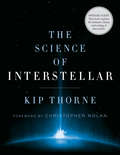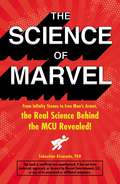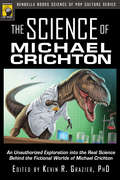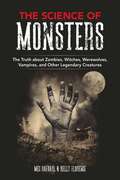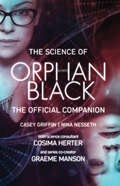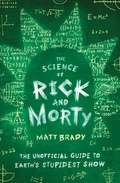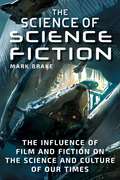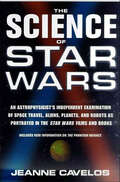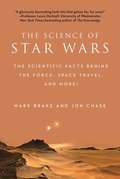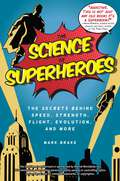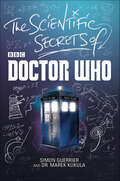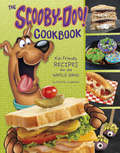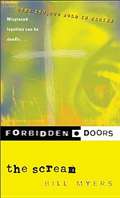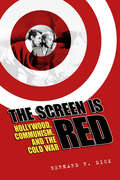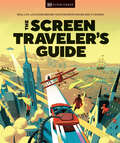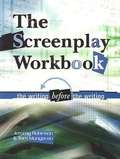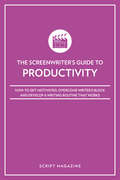- Table View
- List View
The Science of Interstellar
by Kip ThorneA journey through the otherworldly science behind Christopher Nolan's highly anticipated film, Interstellar, from executive producer and theoretical physicist Kip Thorne.
The Science of Marvel: From Infinity Stones to Iron Man's Armor, the Real Science Behind the MCU Revealed!
by Sebastian AlvaradoScience meets fantasy in this behind-the-scenes look at the Marvel Cinematic Universe—now you can experience the magic of the movies, and learn how to replicate it in real-life. The Marvel Cinematic Universe is filled with extraordinary humans and abilities. There are teenaged geniuses swinging through the streets of New York, billionaires creating impenetrable armor in hidden caves, and aliens flying through wormholes to Earth. All of these characters seem to lie firmly in the realm of fantasy—but the technology behind them might not be as farfetched as you think… The Science of Marvel pulls back the curtain and reveals the secrets behind Marvel movie magic, and shows us how to recreate these comic book wonders in our everyday life. Using quantum physics, a little bit of mechanical engineering, and some out-of-the-box thinking, you’ll be amazed to discover that it’s possible to create a real-life Captain America, Incredible Hulk, or Black Panther. The perfect gift or collectible for Marvel fans everywhere, The Science of Marvel brings beloved movies and characters to life like never before.
The Science of Michael Crichton: An Unauthorized Exploration into the Real Science Behind the Fictional Worlds of Michael Crichton
by Michael CrichtonMichael Crichton’s thrillers traverse the cutting edge of science and then push the envelope. How realistic are his takes on subjects ranging from dinosaur cloning to global warming, nanotechnology to time travel, animal behavior to human genetics? The Science of Michael Crichton gathers essays from prominent experts that examine the amazing inventions of Crichton’s books and lift up the hood, revealing the science underneath—exploring which Crichton imaginings are feasible and which are just plain impossible. Computer science innovator Ray Kurzweil looks at how virtual reality is portrayed in The Terminal Man; anthropologist Ian Tattersall takes on Crichton’s depiction of Neanderthals in Eaters of the Dead; meteorologist David Lawrence discusses global warming in State of Fear—and much more, in a fascinating volume that separates the science from the fiction.
The Science of Monsters: The Truth about Zombies, Witches, Werewolves, Vampires, and Other Legendary Creatures
by Meg Hafdahl Kelly FlorenceA must-have for any fan of horror and fantasy movies—Night of the Living Dead, A Nightmare on Elm Street, The Shining (Stephen King), and so many more! If you love film that scares, and want to believe that zombies, vampires, and other deadly and terrifying creatures could be real, let Meg Hafdahl and Kelly Florence, the women behind the Horror Rewind podcast called “the best horror film podcast out there” by Film Daddy, take you to the world where horror and science meet. How would a zombie really decompose in Night of the Living Dead?Are there instances of shape shifting in nature like in The Wolf Man?What is the science behind the night terrors that inspired the creation of Freddy Krueger?Is there scientific data supporting ghost detection like the tools used in Poltergeist?What is the psychological drive that compels cannibals like Hannibal Lecter?How does modern medicine and therapy differ from what would have been offered to Norman Bates in 1960?How are subliminal messages related to propaganda or brainwashing like in The Ring?What would the scientific explanation be for witches possessing people like in Carrie?Was The Blair Witch Project based on any real or imagined creature that came before?”And so much more! Gothic media moguls Meg Hafdahl and Kelly Florence revisit the films from their childhood to discover the science behind the fear. Join Kelly and Meg as they unravel the medical mysteries and scientific marvels that inspired the creation of famous monsters like Nosferatu, Norman Bates, Dracula, Frankenstein, and many more. An approachable and frightfully fun examination of what goes bump in the night, The Science of Monsters will thrill every horror fan.
The Science of Orphan Black: The Official Companion
by Casey Griffin Nina Nesseth Cosima Herter Graeme MansonAn official guide to the crazy science of Orphan Black—from cloning to chimerism and much more. Delve deeper into the scientific terms and theories at the core of the Peabody-winning cult-favorite show. With exclusive insights from the show&’s co-creator Graeme Manson and science consultant Cosima Herter, The Science of Orphan Blacktakes you behind the closed doors of the Dyad Institute and inside Neolution, with color photos included. Authors Casey Griffin and Nina Nesseth decode the mysteries of Orphan Black—from the history of cloning, epigenetics, synthetic biology, chimerism, the real diseases on which the clone disease is based, and the transhumanist philosophies of Neolution, to what exactly happens when a projectile pencil is shot through a person&’s eye and into their brain.
The Science of Rick and Morty: The Unofficial Guide to Earth's Stupidest Show
by Matt BradyExplore the real science behind the Cartoon Network phenomenon Rick and Morty—one of television’s most irreverent, whip-smart, and darkly hilarious shows—and discover how close we are to Rick’s many experiments becoming a reality. Adult Swim’s Rick and Morty is one of the smartest (and most insane) shows on television. Genius alcoholic Rick Sanchez and his hapless grandson Morty have explored everything from particle physics to human augmentation and much more in their intergalactic adventures through the multiverse. With biting humor and plenty of nihilism, Rick and Morty employs cutting-edge scientific theories in every episode. But, outside of Rick’s garage laboratory, what are these theories truly about and what can they teach us about ourselves? Blending biology, chemistry, and physics basics with accessible—and witty—prose, The Science of Rick and Morty equips you with the scientific foundation to thoroughly understand Rick’s experiments from the show, such as how we can use dark matter and energy, just what is intelligence hacking, and whether or not you can really control a cockroach’s nervous system with your tongue. Perfect for longtime and new fans of the show, this is the ultimate segue into discovering more about our complicated and fascinating universe.
The Science of Science Fiction: The Influence of Film and Fiction on the Science and Culture of Our Times
by Mark BrakeWe are the first generation to live in a science fiction world.Media headlines declare this the age of automation. The TV talks about the coming revolution of the robot, tweets tell tales of jets that will ferry travelers to the edge of space, and social media reports that the first human to live for a thousand years has already been born. The science we do, the movies we watch, and the culture we consume is the stuff of fiction that became fact, the future imagined in our past—the future we now inhabit.The Science of Science Fiction is the story of how science fiction shaped our world. No longer a subculture, science fiction has moved into the mainstream with the advent of the information age it helped realize. Explore how science fiction has driven science, with topics that include:Guardians of the Galaxy: Is Space Full of Extraterrestrials?Jacking In: Will the Future Be Like Ready Player One?Mad Max: Is Society Running down into Chaos?The Internet: Will Humans Tire of Mere Reality?Blade Runner 2049: When Will We Engineer Human Lookalikes?And many more! This book will open your eyes to the way science fiction helped us dream of things to come, forced us to explore the nature and limits of our own reality, and aided us in building the future we now inhabit.
The Science of Star Wars: An Astrophysicist's Independent Examination of Space Travel, Aliens, Planets, and Robots as Portrayed in the Star Wars Films and Books
by Jeanne CavelosCould the science fiction of Star Wars be the actual science of tomorrow?-How close are we to creating robots that look and act like R2-D2 and C-3PO?-Can we access a "force" with our minds to move objects and communicate telepathically with each other?-How might spaceships like the Millennium Falcon make the exhilarating jump into hyperspace?-What kind of environment could spawn a Wookiee?-Could a single blast from the Death Star destroy an entire planet?-Could light sabers possibly be built, and if so, how would they work?-Do Star Wars aliens look like "real" aliens might?-What would living on a desert planet like Tatooine be like?-Why does Darth Vader require an artificial respirator?Discover the answers to these and many other fascinating questions of physics, astronomy, biology and more, as a noted scientist and Star Wars enthusiast explores The Science of Star Wars.
The Science of Star Wars: The Scientific Facts Behind the Force, Space Travel, and More!
by Mark Brake Jon ChaseDiscover the science behind the most popular sci-fi franchise of all time.Capturing the imagination and hearts of crowds worldwide, Star Wars is a fantastic feat of science fiction and fantasy. <P><P>We marvel at the variety of creatures and technology and the mystery behind the force. But how much of the Star Wars world is rooted in reality? Could we see some of the extraordinary inventions materialize in our world? <P><P>The Science of Star Wars addresses fifty topics that span the movies' universe such as battle technology, alien life, space travel, etc. You'll find fascinating explorations of physics, plausibility, and more. The book addresses many unanswered, burning questions including: <P><P>How long before we get a Star Wars speeder off the ground? <P><P>What exactly is the Force? <P><P>How could Kylo Ren stop a blaster shot in mid-air?How could we live on a gas giant like Bespin?Nature versus nurture: How does it play out in the making of Jedi? <P><P>How much would it cost to build the Death Star? <P><P>And much more!Written for every fan of the films, you don't need to be a Jedi or a scientist to appreciate all of Mark Brake and Jon Chase's fun and informative analysis of this classic series. Prepare your mind to make the jump to light speed and find out about the facts behind one of our favorite modern epics.
The Science of Superheroes: The Secrets Behind Speed, Strength, Flight, Evolution, and More (The\science Of Ser.)
by Mark BrakeDiscover the science behind the abilities of your favorite superheroes! The concept of the superhero has permeated our culture. They fascinate their fans with their incredible superhuman abilities and impressive technology. But do you ever wonder if any of it is plausible or rooted in fact? Enter The Science of Superheroes, which address more than fifty topics that span the worlds of your favorite superheroes and villains. Explore and examine their amazing abilities and fantastic gadgets with a detailed scientific lens. The scientific questions examined within this book include: Can an Iron Man suit be made? How does Thor's hammer work? Could any known forms of radiation cause superpowers? How many calories does Superman need each day? Could you cross a Lamborghini and a hummer to make the Batmobile Tumbler? And many more! Whether you're a movie or comic buff, this book is certain to entertain and open your eyes to the truth behind these amazing characters.
The Science of The Big Bang Theory: What America's Favorite Sitcom Can Teach You about Physics, Flags, and the Idiosyncrasies of Scientists (The Science of Series)
by Mark BrakeThe geeks will inherit the earth.With well over two hundred episodes and a dozen seasons, The Big Bang Theory is one of America’s favorite television series, bringing a new class of character to mainstream television: the science nerd.In spite of its evident popularity and influence in shaping public attitudes to science and scientists, there are relatively few books that explore the show’s culture and social dimension. The Science of The Big Bang Theory looks behind the comedy scenes and scripts of this long-running and successful TV show to explore topics such as:The Bachelor Party Corrosion and ArchimedesThe Valentino Submergence: Fun with FlagsThe Dumpling Decoupling: Sheldon and Doctor WhoThe Mystery Date Observation: The Unlikely Dating Habits of EggheadsAnd More!This book is a light-hearted science companion to TV's The Big Bang Theory, providing you with just the kind of dissection of the science and culture you’d need to understand “math, science, history, unraveling the mysteries, that all started with the big bang! Hey!”
The Scientific Secrets of Doctor Who
by Simon Guerrier Marek KukulaThe Scientific Secrets of Doctor Who is a mind-bending blend of story and science that will help you see Doctor Who in a whole new light, weaving together a series of all-new adventures, featuring every incarnation of the Doctor.With commentary that explores the possibilities of time travel, life on other planets, artificial intelligence, parallel universes and more, Simon Guerrier and Dr. Marek Kukula show how Doctor Who uses science to inform its unique style of storytelling—and just how close it has often come to predicting future scientific discoveries.This book is your chance to be the Doctor's companion and explore what's out there. It will make you laugh, and think, and see the world around you differently.
The Scooby-Doo! Cookbook: Kid-Friendly Recipes for the Whole Gang (Scooby-Doo!)
by Katrina JorgensenGuaranteed to solve any case of hunger! This official Scooby-Doo! cookbook features—Zoinks!—more than 25 kid-friendly recipes from the Mystery Inc. gang, including Scooby’s favorite treats, Shaggy’s must-have cheese-and-pickles pizza, jaw-stretcher sandwiches, and other easy recipes. Jam-packed with bright photos, cooking basics, and fun facts from the ever-popular show, the SCOOBY-DOO! COOKBOOK is sure to please fans of all ages, from meddling kids to adults. Rummy
The Scotland Yard Puzzle Book: Test Your Inner Detective by Solving Some of the World's Most Difficult Cases
by Sinclair McKayPit your wits against the brilliant minds of Scotland Yard and see if you have what it takes to solve dozens of the world's toughest crimes."Scotland Yard" conjures up so much more than just London's Metropolitan Police. Since it opened its doors in 1829, Scotland Yard has been synonymous the world over with the highest level of detective work and famous for its ability to solve the most macabre of murders and catch the most audacious of thieves.The Scotland Yard Puzzle Book mines the history of this famous institution to recreate some of the most complex conundrums its detectives have ever faced. Armchair detectives can now try their hand and keen powers of observation and deduction to solve for themselves dozens of the most difficult and challenging cases.Activities include:Anagrams and cryptogramsLogic, linguistic, and mathematical puzzlesMap puzzlesCoded and visual puzzlesBrainteasersHidden messagesAnd more (answers are provided in the back of the book)!
The Scream (Forbidden Doors, #9)
by Bill Myers"He has no concept of the danger he's in." Rebecca Williams is about to learn this first hand. She and her brother, Scott, are going to L.A. to the hottest concert in the country. What could be better than that? Rebecca knows she should be excited, but since she read Z's e-mail all she feels is apprehension. They've been asked to help the drummer for The Scream, the nation's top rock band. Rebecca has faced danger before -- so why does this assignment have her so on edge? Join Becka and Scott as they learn valuable truths about the lure of the supernatural, the reality of spiritual warfare -- and the truth of victory in Jesus. Ouija boards, witchcraft, voodoo, vampires and more are covered in these edge-of-your-seat thrillers for teens. Recommended for ages 12 and up.
The Screen Combat Handbook: A Practical Guide for Filmmakers
by Kevin InouyeThe Screen Combat Handbook is an essential guide to navigating the unique challenges of putting combat on screen. Explore the process from the early stages of preproduction planning all the way through to editing and sound design, and everything in-between. This book uses practical instruction, examples, interviews, and illustrations to show how to plan, shoot, and assemble safe and effective fight sequences. It includes sections on thoughtful and practical design choices in set, wardrobe, props, and effects, preproduction planning, on-set protocol, fight choreography and coordination, shot planning and technical tricks, acting choices, effective cinematography, and impactful editing and sound design. It provides an invaluable resource for all those involved including directors, fight coordinators, actors and stunt players, and any filmmaker attempting to shoot an exciting action scene safely. Whether working on a no-budget indie production or on a professional set, this is your ultimate guide to screen combat and fight choreography.
The Screen Is Red: Hollywood, Communism, and the Cold War
by Bernard F. DickThe Screen Is Red portrays Hollywood's ambivalence toward the former Soviet Union before, during, and after the Cold War. In the 1930s, communism combated its alter ego, fascism, yet both threatened to undermine the capitalist system, the movie industry's foundational core value. Hollywood portrayed fascism as the greater threat and communism as an aberration embraced by young idealists unaware of its dark side. In Ninotchka, all a female commissar needs is a trip to Paris to convert her to capitalism and the luxuries it can offer. The scenario changed when Nazi Germany invaded the Soviet Union in 1941, making Russia a short-lived ally. The Soviets were quickly glorified in such films as Song of Russia, The North Star, Mission to Moscow, Days of Glory, and Counter-Attack. But once the Iron Curtain fell on Eastern Europe, the scenario changed again. America was now swarming with Soviet agents attempting to steal some crucial piece of microfilm. On screen, the atomic detonations in the Southwest produced mutations in ants, locusts, and spiders, and revived long-dead monsters from their watery tombs. The movies did not blame the atom bomb specifically but showed what horrors might result in addition to the iconic mushroom cloud. Through the lens of Hollywood, a nuclear war might leave a handful of survivors (Five), none (On the Beach, Dr. Strangelove), or cities in ruins (Fail-Safe). Today the threat is no longer the Soviet Union, but international terrorism. Author Bernard F. Dick argues, however, that the Soviet Union has not lost its appeal, as evident from the popular and critically acclaimed television series The Americans. More than eighty years later, the screen is still red.
The Screen Traveler's Guide: Real-life Locations Behind Your Favorite Movies and TV Shows
by DKPut yourself in the movie! Step inside dozens of real-life locations with this gloriously geeky, map-filled compendium.Locations are everything. They transport us to far-flung worlds and dystopian futures, and provide the backdrop to intergalactic battles and rampaging monsters. Our most obsessed-about stories would be nothing without them.Meticulously researched and compiled by self-proclaimed superfans and travel experts, The Screen Traveler&’s Guide maps the real-life locations behind your favorite shows and scenes. Follow the Avengers&’ battle of New York, discover the Croatian location for Game of Thrones&’ King&’s Landing, find out how New Zealand transformed into Lord of the Rings&’ Middle Earth, uncover exactly where the magical world of Harry Potter is set – and much more.Along the way, you&’ll discover the landmarks to avoid during an alien invasion, the strangest location stand-ins (did you know, for example, that Liverpool stood in for Brooklyn in Captain America?), the place that&’s doubled as more countries than any other, and lots of travel inspiration from your pop culture cornerstones. Welcome to the ultimate travel guide for every screen geek.
The Screenplay Workbook: The Writing Before the Writing
by Jeremy Robinson Tom MungovanThis perforated-page workbook for students learning to write screenplays includes numerous worksheets, charts, and fill-in lists designed to help students focus on essential aspects of the screenplay. Worksheets are provided for concept creation, character development and relationships, plot structure, plot points, character arc, and scenes. Online resources are listed and described. The authors are screenplay writers. Annotation (c)2003 Book News, Inc. , Portland, OR (booknews. com)
The Screens of Virtual Production: What is Real?
by Sean Redmond Lienors Torre Sian Mitchell Colin PerryThis book is the first dedicated edited collection that explores the virtualisation of screen-making processes from pre-production to post-production, while attuning to the aesthetic, ideological and performative contexts upended by these integrated technologies. This book explores what is real in virtual production, as a provocative one, implicitly drawing on the philosophies of the moving image and the recent work on new forms of post-human perceptual realism.This edited collection is divided into the following four themed sections. Section One, It’s Always Been Real: Contemporising Virtual Production, addresses the histories of film realism in relationship to visual technologies, providing both a theoretical and philosophical ‘anchor’ point for the collection, and a necessary genealogy. Section Two, The Body Becomes You: Performing Virtual Production, examines the transformation that occurs in immersive virtual worlds, while also exploring how the body is itself virtualised. Section Three, Skin Deep: Gazing with Virtual Production, addresses the way race, ethnicity, gender and environment are supposedly equalised, and yet are still found to reproduce the colonised looking regimes of western, mainstream screen culture. Section Four, Whose Work? Labouring with Virtual Production, draws together writing that examines the way production processes have been transformed, affecting not only work patterns but also the way aesthetics, form and function, operate.This book encompasses many production themes and will appeal to media students and professionals interested in the production of film.
The Screenwriter Activist: Writing Social Issue Movies
by Marilyn BekerHotel Rwanda. Philadelphia. Silkwood. Some of the most important films ever made have tackled real-world social issues, from genocide to homophobia to corporate greed. As storytellers, activist screenwriters recognize that social issues make great stories that can be gut-wrenching, heart-tugging, funny, tragic, and interesting to watch. The Screenwriter Activist helps screenwriters tell those stories in compelling, non-preachy, and inspiring ways. The Screenwriter Activist is an in-depth, practical guide, appropriate for students in intermediate or graduate screenwriting courses in Film and English Programs as well as professionals who want to write a movie that can make a difference in the world. Using examples from classic and recent popular films, The Screenwriter Activist: Explores the motivation and sensibility a screenwriter needs to embark on a social issue project Gives techniques for choosing compelling subjects Provides historical context for social issue movies Explains how characters legitimize social issue themes Puts forward specific models for structuring advocacy screenplays Lays out a roadmap for how screenwriters can get a social issue movie made If you care deeply about social issues and recognize that films can be highly effective platforms for motivativng audiences to civic involvement and social action, this is the one screenwriting book you need to read.
The Screenwriter Looks at the Screenwriter
by William FrougTwelve of Hollywood's top screenwriters discuss their craft and their lives, including: Johnson 'Grapes of Wrath', Diamond 'Some Like It Hot', Henry 'The Graduate', and Lardner 'M*A*S*H'.
The Screenwriter Within: How to Turn the Movie in Your Head into a Salable Screenplay
by D. B. GillesIf you've ever dreamed of writing a screenplay,The Screenwriter Withinis the book for you. Insightful, inspirational, and wildly irreverent, it takes you through all the stages of the writing process, using references to hit movies and the author's personal experience to show you how to: Turn everyday events into big-screen successes Find the best stories to turn into screenplays Develop strong characters Write compelling dialogue Find your niche as a screenwriter . . . and much more.
The Screenwriter's Guide to Agents and Managers
by John Scott LewinskiThe lessons to be learned from this helpful guide show aspiring screenwriters, television writers, and novelists how to catch an agent's eye and develop a successful scriptwriting career. Step-by-step instructions reveal how to get around the "Catch 22" of the trade-that you can't get an agent until you've sold a script. Interviews with prominent agents and managers disclose how the power brokers choose material, what kinds of writers command their attention, and what they expect from the writers they sign on. Tips on how to write a winning spec script, how to word an effective query letter, how to forge a sound relationship with reps, and other invaluable advice fill this insider's guide.
The Screenwriter's Guide to Productivity: How to Get Motivated, Overcome Writer's Block and Develop a Writing Routine That Works
by Script Magazine EditorsAre you an aspiring screenwriter, but struggling to get the words on the page? So many things can come between you and the keyboard: a 9 - 5 job, writer's block, or good old-fashioned procrastination. Writing Routine and Outlook is a collection of articles from Script Magazine that address the many obstacles that independent screenwriters face when trying to hone their craft. Film industry experts provide advice based on their own experiences and useful tips for making writing a part of your everyday life. Getting in the zone to write can be hard, but there are ways to cut down on the time it takes for you to focus up. These articles will teach you how to make writing into a habit, regardless of how busy you are. You'll learn how to find your optimal time of day for creation and productivity, your own writing process, and a work-life balance. By evaluating the way you currently make use of your time, you'll learn how to restructure your days to make the most of them. You'll learn how setting goals and deadlines for yourself can transform your writing experience, how to avoid the trap of waiting for inspiration, and how to select a day job that pays the bills while facilitating your passion. Writing Routine and Outlook also includes tips for boosting your creativity, finishing your screenplay, and turning your procrastination into productivity.
